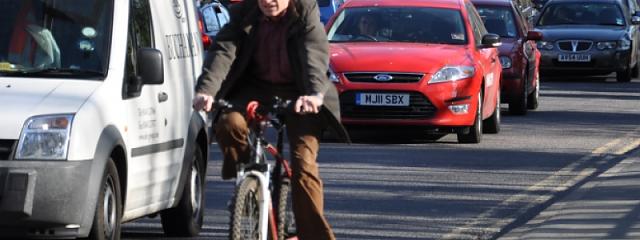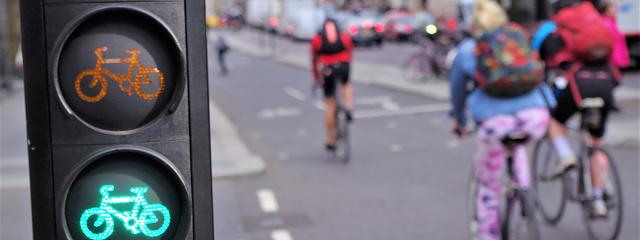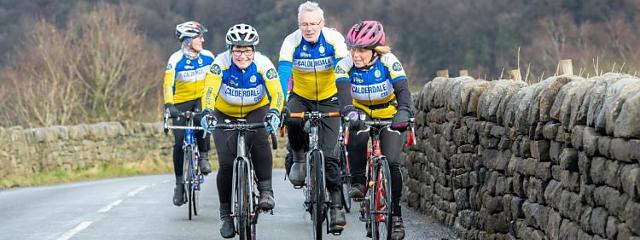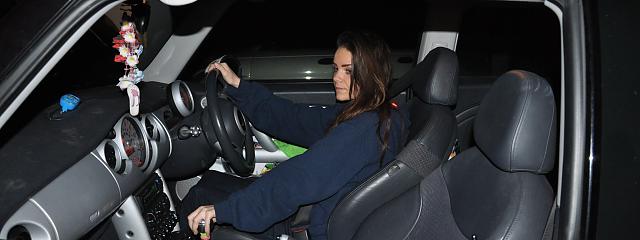
Sharing the road with cyclists: Tips for drivers
Sharing the road with cyclists: Tips for drivers
Background
This article explains what Cycling UK thinks drivers need to know about behaving round cyclists. It’s such essential knowledge that we also believe that it should be embedded into the driver training, (re)testing and licensing process – we cover this aspect in a separate article.
Self-evidently, cyclists (and pedestrians) are considerably more vulnerable on the roads than the occupants of motor vehicles. This means that cyclists depend heavily on responsible behaviour from drivers, and need them to understand their vulnerability and how to interact with them safely.
This is more important than ever now that drivers are encountering more cyclists more often on the roads: over the last ten years, cycle mileage has grown in Britain: 3.45 billion vehicle miles were cycled in 2016, compared to 2.80 in 2006 (+23%).
Cyclists’ vulnerability and fault in collisions
While inattention, bad driving and conscious law-breaking are of concern to all road users, it is especially alarming for the most vulnerable.
Perhaps most crucially for cyclists in general, their own behaviour is less likely to be at fault in reported collisions than that of drivers: cycles, along with buses/coaches, are the vehicle-type least likely to have ‘contributory factors’ (CFs) attributed to them by the police. A detailed report, commissioned by the Department for Transport (DfT), also found this to be the case.
Cyclists, of course, suffer not only from impact collisions, but are regularly subject to off-putting ‘near misses’ too. As the author of a research paper published in 2015 said:
“Frightening or annoying non-injury incidents, unlike slight injuries, are an everyday experience for most people cycling in the UK. For regular cyclists 'very scary' incidents (rated as 3 on a 0-3 scale) are on average a weekly experience, with deliberate aggression experienced monthly. Per mile, non-injury incidents were more frequent for people making shorter and slower trips. […] Incidents that involved motor vehicles, especially those involving larger vehicles, were more frightening than those that did not.”
This suggests that much more effort should be made to instil in drivers a better understanding of cyclists and how to drive safely round them.
The need for greater cycle awareness
We know that, in general, drivers tend to stereotype cyclists negatively. Research has found that they can be critical of cyclists’ actions without understanding why they behave as they do, find them unpredictable, see them as an ‘out group’ who all exhibit the same ‘faults’, and even feel stressed by their vulnerability.
These negative attitudes and lack of understanding go a long way to explain why the behaviour of some drivers, inadvertently or wilfully dangerous, makes road conditions hostile for so many cyclists.
What drivers need to know
Cycling UK has identified a range of actions from drivers that put cyclists at risk or are known to cause injuries and fatalities, particularly:
- failing to look before turning at junctions and/or roundabouts;
- speeding;
- distraction (e.g. by mobile phones);
- close overtaking (including on bends); and
- opening car doors without looking.
Also, we know that some drivers feel aggravated when they find cyclists ‘in the way’ - e.g. riding away from the kerb or in the middle of a traffic lane. This may well be because drivers are unaware of the advice given to cyclists by the National Standard for cycle training, i.e. to ride away from the gutter to avoid any surface defects and drain covers, to be visible, and to ‘take the lane’ to deter drivers from overtaking them when there is not enough room to do so safely.
Cyclists are often criticised too for not using a dedicated facility alongside the road, or riding two abreast. Again, this implies both misinformation and ignorance. Some routes by the side of the carriageway are poorly surfaced or maintained, and/or they may force cyclists to give way and make unsafe crossings of side roads at junctions, meaning that it might be safer (as well as quicker) to stay on the carriageway. Equally, riding two abreast is not an offence - some cyclists, especially if in groups, deliberately take on the formation to stop drivers from overtaking when the manoeuvre could be dangerous. See Cycling UK's 'What's legal and what's not on your bike' for more.
As another research report said in 2002:
“Education of drivers should focus not on helping them to predict cyclist behaviour but on understanding that circumstances will influence that behaviour.”
“Drivers’ education […] should include advice on how to respond when encountering cyclists at certain types of road feature, both those explicitly providing for cyclists and other highway features. More clearly defining the appropriate responses may assist drivers in knowing how to behave more considerately and in resisting social pressure from other drivers to force their way past cyclists.”
In theory, promoting a better understanding between cyclists and drivers should not be too great a challenge: much of the type of behaviour from motorists that puts other drivers under stress is exactly the same as the type of driving behaviour that puts cyclists at risk and/or makes them feel unsafe. Cycling UK believes that, for both national and local government to fulfil their duties to promote road safety and training, drivers must be made aware of the issues listed in the table below
Cycle awareness: key messages for drivers
- Always look carefully for cyclists before: pulling out at a junction or roundabout; making any turning manoeuvre; or changing lanes in slower-moving/stationary traffic. Make it obvious that you have seen them (apparent inattention is confusing), and signal intentions clearly.
- Before turning out of one road into another, wait for any cyclist riding along the other road to pass. Do not turn out in front of them.
- Leave plenty of space when overtaking a cyclist, i.e. at least a car’s width when overtaking at lower speeds (20-30 mph). Allow even more space: (a) when travelling at higher speeds; (b) when driving a lorry or other large vehicle; (c) in poor weather (rain makes it harder for cyclists to see potholes and reduces grip; and wind gusts can cause them to wobble); (d) on left-hand bends. Never cut in/turn left sharply after overtaking a cyclist.
- Wait for a cyclist to ride through a pinch point / road narrowing before driving past, unless absolutely certain that there is enough room to overtake at a safe distance.
- Do not try to squeeze past oncoming cyclists if there is not enough room to do so safely.
- Drive at a considerate speed; do not accelerate or (without very good reason) brake rapidly around cyclists; or follow them impatiently/too closely (‘tailgating’ intimidates drivers too).
- Understand how ASLs and mandatory/advisory cycle lanes work and the regulations that apply. Also, be aware of cycle symbols painted on the road and understand why they are there.
- Do not park in cycle lanes: this can force cyclists to pull out riskily into the main stream of traffic.
- Do not get impatient with cyclists who ride away from the kerb/parked cars. Cyclists are trained not to hug the kerb. This is because it increases their visibility and helps them avoid the risks of: (a) parked car doors opening on them; b) being overtaken where this would be dangerous; and (c) having to swerve towards the main traffic stream to avoid potholes.
- Look out for cyclists before opening a car door, and make sure passengers do too. Be aware that it is an offence to injure or endanger someone by opening a vehicle door, or even permit it.
- It is not compulsory for cyclists to use cycle tracks beside the road. All too many tracks are not properly designed/maintained, and/or may be obstructed. It is often better for cyclists (especially faster cyclists) to ride on the carriageway, both for their own and pedestrians’ safety and comfort.
- Cyclists riding in groups are not required to keep in single file and often ride two abreast on narrow and winding lanes in the interests of safety. If they form a long, single-file line, drivers may try to overtake only to find that they are forced to pull in dangerously by oncoming vehicles. Riding two abreast is a way of deterring drivers from dangerous overtaking manoeuvres.













Comments
Another particularly dangerous manouevre
Overtaking then immediately turning left - if the overtaker cannot clearly see down the road they are entering they could be forced to stop suddenly in front of the cyclist giving them nowhere to go.
Andy